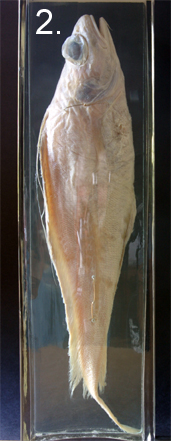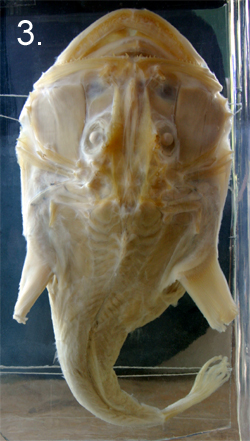
SUPERORDER PARACANTHOPTERYGII
The superorder Paracanthopterygii was created to remove from the superorder Acanthopterygii all the species that lacked the features of the ‘typical’ acanthopterygian. However the resulting assemblage of 1200 species of predominantly marine fish includes very diverse fish types – from the ‘classical fish- shaped’ cod in the order Gadiformes to the bizarrely shaped angler fish in the order Lophiformes – and may not be a natural group.
 |  |  |
1. Gadus morhua, Atlantic cod (Order Gadiformes, Family Gadidae). The Atlantic cod feeds on bottom-dwelling organisms: crabs, molluscs and fish. It employs a potentially highly successful small egg/high fecundity reproductive strategy. In spite of this potential, cod populations have not been able to withstand the extreme pressures placed on them by over fishing. This specimen is 40 cm long.
2. Nezumia aequalis, Common Atlantic grenadier (Order Gadiformes, Family Macrouridae). The 285 species of grenadiers or rat tails, so-called on account of their large heads and tapering tails, are major predators and scavengers of the deep sea bottom. This specimen is 28 cm long.
3. Lophius piscatorius, Angler fish (Order Lophiformes, Family Lophidae). The 280 - 300 species of angler fish are either bottom-dwelling fish or deep sea predators. Bottom-dwelling angler fish, like this specimen, have an irregular shape and cryptic coloration that camouflages them as they wait for prey to be attracted by the lure on a ‘fishing pole’ which grows from the top of their heads. Angler fish or goose fish will consume anything they can trap; their only predator is apparently the sperm whale. They live offshore mostly in shallow water (500m) until the breeding season when they move to deeper water (1800m) to spawn. L. piscatorius lives in the North and South Atlantic and may reach 1.8 m. This specimen is 25 cm long; it has lost its lure.






